Abstract
Until the late 20th century, the idea of identifying wildfires in deep time was not generally accepted. One of the basic problems was the fact that charcoal-like wood fragments, so often found in sedimentary rocks and in coals, were termed fusain and, in addition, many researchers could not envision wildfires in peat-forming systems. The advent of Scanning Electron Microscopy and studies on modern charcoals and fossil fusains demonstrated beyond doubt that wildfire residues may be recognized in rocks dating back to at least 350 million years. Increasing numbers of studies on modern and fossil charcoal assemblages from the 1970s through the 1990s established the potential importance of wildfires in the fossil record, using Carboniferous examples in particular. Since the 1990s, extensive progress has been made in understanding modern wildfires and their byproducts. New techniques to study ancient charcoals have allowed considerable progress to be made to integrate modern and ancient fire studies, both before and after the evolution of mankind. Four important developments have made a reassessment of Carboniferous wildfires necessary: the recognition of the role of atmospheric oxygen in controlling the occurrence of wildfire; the development of new microscopical techniques allowing more detailed anatomical data to be obtained from charcoal; the integration of molecular studies with the evolution of fire traits; and new developments in or understanding of post-fire erosion/deposition systems.
Keywords:
wildfire; charcoal; post-fire erosion; microscopy; evolution; oxygenation; plant traits; Mississippian; Pennsylvanian 1. Introduction
In 1958, Tom Harris published a landmark paper [] on forest fires in the Mesozoic. This was mainly based upon the discovery of charred plants in Rhaetic fissure deposits from South Wales []. However, even then, many still did not believe in the occurrence of charcoal in the fossil record that was termed fusain by Marie Stopes []. Despite the abundance of fusain in the Carboniferous, few authors embraced the perspective that this material was really charcoal nor that it was evidence of wildfires in deep time [] (see Scott [] for a discussion of the history of the fusain/wildfire debate). Scott [] described the earliest known Carboniferous conifer preserved as charcoal and studied the material using scanning electron microscopy. It became evident through the 1970s and 1980s that wildfire occurrence in the Carboniferous was more widespread than previously thought, although objections concerning the nature of charcoal in the fossil record remained a sticking point for many [,] (see for example the discussion in Scott and Collinson []). During this time, much effort was exerted to determine the identity of charcoal in the fossil record and, hence, the implications of its occurrence (see for example [,,,,,,,,,,,]).
While we had a restricted understanding of wildfire in deep time, it was also the case that our understanding of wildfire in the present-day ecosystems was much more limited, especially with regard to global reach and frequency as well as to the products of wildfires (see [,,,,]).
In 1994, Scott and Jones published a paper [] regarding the state of knowledge of the Carboniferous, its recognition, and its significance using data from a number of newly discovered Carboniferous sites and incorporating both experimental data and observations on modern fires and their impacts. Between 1994 and the mid-2000s, while we still had an increasing recognition of the importance of fire in deep time (e.g., [,]), it was the publication of the paper by Bowman et al. [] that brought the significance of the geological history of wildfire to a broader audience []. It has now been 30 years since the publication of Scott and Jones [] concerning Carboniferous wildfires, which seems an appropriate time to examine the progress that has been made towards our understanding of this important period of Earth history.
1.1. Modern Fires and Charcoal Formation
Before the 1980s, there had been little research on modern wildfire charcoal residues [,]. Komarek [] had recognized the importance of charcoal production from modern wildfires and its potential for interpreting ancient wildfires. In addition, he had characterized charcoal fragments that were found in smokes from fires [] Griffin and Goldberg [] also considered the occurrence of charcoal particles in ocean sediments. The transport of charcoal both by wind and water had been highlighted by Patterson et al. []), but still little was known of the organ or species composition of such residues [,,]. In their paper, Scott and Jones [] not only summarized what was known about wildfire residues but also provided new data from a number of recent wildfires. These included an examination of residues from the Yellowstone fires of 1988 [,,,], as well as the heathland fires from southern England and also those from southern France. Scott and Jones [] looked at the nature of some of these charcoal assemblages, including an analysis of the size ranges of modern wood charcoals. It was becoming clear that more data on modern charcoal assemblages were needed.
Progress since 1994: Following the research of Scott and Jones [] opportunities were sought to examine wildfire residues in more detail. Heathland fires in southern England during the mid-1990s allowed for a detailed study of the short-term and long-term fate of charcoals. The fire site at Tilford/Frensham in Surrey was visited while the fire was still being extinguished. The burned tract belonged to a protected area with well-known vegetation. A series of 0.5 m quadrats were deployed across the burned site and the burned materials were collected. These samples were analyzed in terms of plant organ size and identity and the material was studied using scanning electron microscopy (Figure 1). These data were published by Scott et al. [] and suggested that all vegetative types, including mosses and small flowers, were well represented by the charcoal assemblages (Figure 1). In addition, samples were collected both before and after the first rainstorms and then subsequently for the next 2 years to examine charcoal transport. This showed that initially wind played an important role in concentrating small plant organs and even formed wind ripple concentrates of charcoalified flowers (Figure 1a). Later observations at other heathland burn sites showed a similar phenomenon [,]. A series of observations on vegetation at other burn sites, including coniferous-dominated wildfire areas (Figure 2 and Figure 3), demonstrated the complexity of the composition of the charcoal-dominated ashes []. The majority of the charcoalified wood arose from charred dead wood rather than from the wood of living trees (Figure 2b). Scott [] concluded that the majority of the charcoals produced during the wildfire (Figure 3) originated from dead litter or shrubby surface vegetation. Several additional points of inquiry regarding the formation and preservation of charcoal, including how different plants burn and produce charcoal [,,], have yet to be fully investigated, but the fact that charcoal assemblages may provide considerable information on past wildfires is evident from the research that has been conducted [,,,,].
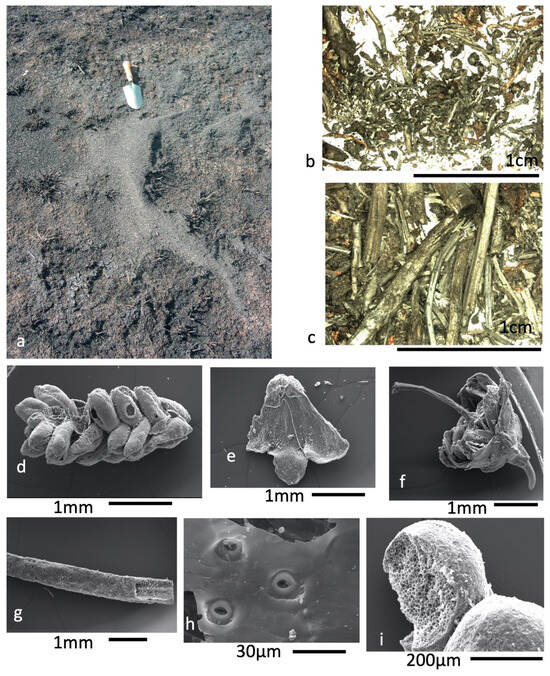
Figure 1.
Charcoal from modern heathland fires, Surrey, England. (a) Wind-formed ripple concentrating charcoal of heather flowers. (b) Light micrograph of charcoalified flower concentrate. (c) Charcoal assemblages with heather, pine, and birch charcoal. (d) SEM of charcoalified Calluna leafy shoot. (e) SEM of Betula pedula seed scale. (f) SEM of Calluna flower. (g) SEM of Pinus needle. (h) Detail of (g) showing stomata. (i) SEM of Cenococcum fungal sclorotia.
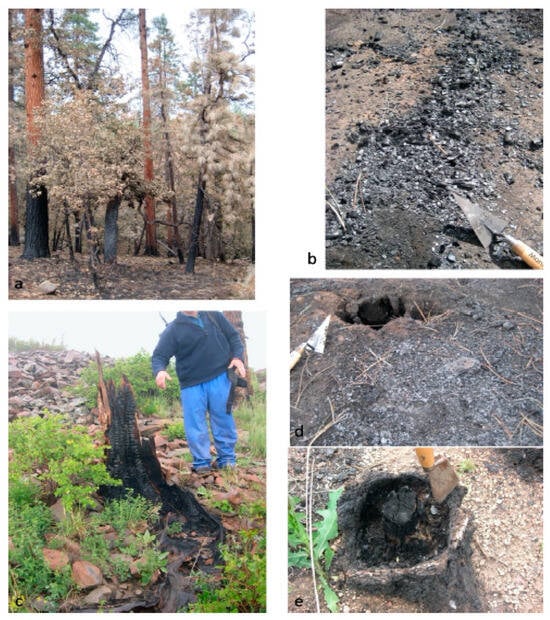
Figure 2.
(a) Charred pine trees after the Oxford Fire (2009), north of Flagstaff, Arizona (photo R. Scott Anderson). (b) Charcoal from dead pine on forest floor. Oxford Fire, 2009 (photo R. Scott Anderson). (c) Charred stump from Colorado fire, 2001. (d) Charcoal from burning of surface vegetation and burned hollow stump, Oxford Fire, 2009 (photo R. Scott Anderson) (e) Charred inside of dead stump of Pinus, 2002 Hayman Fire, Colorado.
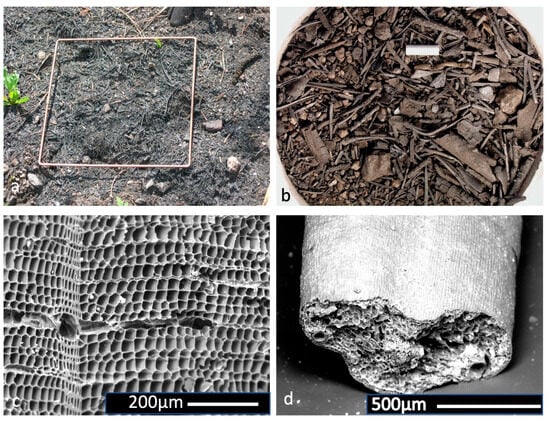
Figure 3.
(a) Charcoal comprising fine charred plant debris, in situ after wildfire. The charcoal is mainly from leaf litter. The square is 50 × 50 cm. Overland Fire (2003), Colorado, USA (after Scott []). (b) Detail of assemblage from (a). (c) SEM of Pinus wood. (d) SEM of Pinus needle.
1.2. Use of Reflectance
Prior to 1994, it was noted that the reflectivity of plant cell walls increases when studied in polished blocks under oil [,], and this discovery was beneficial for the identification of fossil charcoal. This was noted by Scott [] (data published in []) and independently by Correia et al. []. A series of experimental studies led to the demonstration that the reflectance of the cell walls increased in the absence of oxygen with increasing temperature [,,,] and then examined the reflectance of a series of modern and ancient charcoal assemblages demonstrating that both modern and fossil charcoal assemblages had distinctive reflection profiles that they may enlighten our understanding of wildfire behavior. For example, charcoal assemblages from modern heathland fires tended to have reflectances mainly below 3%, whereas wildfire resides from the Yellowstone fires that burned through conifer forests not only had charcoals below 3% but also had a significant peak of reflectance around 5%. It was suggested that this may be the result of recoding charcoal produced in lower-temperature surface fires as opposed to higher-temperature crown fires. The authors used these data to interpret several of the fossil charcoal assemblages.
Progress since 1994: One area that has received attention in both the study of modern and ancient charcoal assemblages is the potential use of charcoal reflectance to provide further data on the nature of wildfires. Scott and Jones [] had suggested that the reflectance of charcoal assemblages may help distinguish between different types of wildfires. It became clear that charcoal could form not only from wildfires but also from volcanic processes []. Studies on Carboniferous volcanic sequences in Scotland showed that we knew little of charcoal formation in such settings []. It became clear that charcoal may form by burial in hot pyroclastic flows and that the charring time may be many hours. New experiments were undertaken that subjected plants to a range of temperatures for much longer times than the one-hour studies previously published. Scott and Glasspool [] showed that after 4 h of exposure to a given temperature, the reflectance of the woods studied in polished blocks under oil did not rise. The implications were not only useful for the study of volcanic charcoals but also for wildfire charcoals. Within the volcanic setting, because many of the exposure times in hot pyroclastic flow deposits were greater than 4 h, the charcoal reflectance could provide important temperature data. The predicted and measured temperatures of pyroclastic flow deposits from the modern eruptions of Montserrat were used by Scott and Glasspool [] to test this hypothesis. In addition, such data could be compared to geochemical data and could also be used to help pyroclastic flow modeling [,]). In addition, charcoal reflectance data were compared with temperature data from palaeomagnetic studies of lithic clasts to demonstrate their use in older pyroclastic flow deposits [].
Unfortunately, charcoal reflectance was beginning to be used to provide interpretations of wildfire type without consideration of the potential pitfalls. Reflectance data on a range of organic materials such as fungi and ferns also suggested a use for the reflectance data short of providing absolute temperatures [,] (Figure 4). McParland et al. [] examined the issue of the re-charring of charcoal as well as emphasizing the potential uses and misuses of modern and fossil charcoal reflectance data. Hudspith, Belcher, and others [,,], in their reflectance studies of modern charcoal, provided both positive and negative uses of the information, but treated the data with care; reflectance data have a role to play in the investigation of modern wildfires. Further, Roos and Scott [] collected charcoals from known wildfire types and showed that they differed in the charcoal reflectance profiles. Such studies are still in their infancy and require further development. In addition to reflectance measurements now commonly undertaken, new techniques such as Raman Spectroscopy Band width ratios (FWHMRa) are also providing charring temperature data, and these data provide another independent measure of heat intensity [].
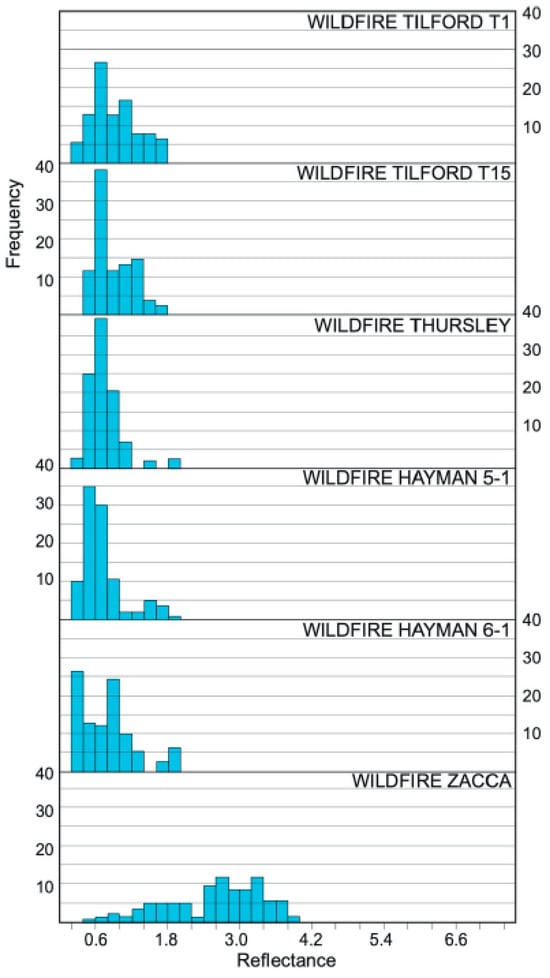
Figure 4.
Frequency histograms to show the distribution of reflectance values for the six charcoal assemblages from natural wildfires, measured in polished blocks under oil (after McParland et al. []).
1.3. Microscopical Developments since 1994
We have already noted that it was the advent of the scanning electron microscope that revolutionized the study of charcoal []. For the first time, small charcoalified fragments could be examined and identified. Scott [] had used this method to demonstrate that both modern charcoalified plants and fossil plants, once described as fusain, showed beautiful anatomical preservation. Even flowers could be preserved as charcoal []). In their study of charcoals following a modern heathland wildfire, Scott et al. [] showed that the charcoal assemblages could give an accurate picture of what was burned and discovered in the residues that had been collected that not only wood, leafy shoots, and fertile organs including pollen and seed cones and flowers could be preserved but even delicate mosses and fungal sclerotia and insects (Figure 1 and Figure 3). Further, these authors showed that the nature of the charcoal assemblage could be modified during transport by wind and water. SEM became the most important technique for the study of fossil charcoal [,] including the study of fossil flowers [] as well as a range of plant organs [] However, one issue was that the internal anatomy was difficult to study in small charcoalified plant organs as they are very brittle. The development in the 2000s of Synchrotron Radiation X-ray Tomographic Microscopy has provided a new tool that allows virtual sections of small charcoalified organs to be imaged non-destructively [,] (Figure 5b,c). In studies of Carboniferous charcoal, this technique has allowed very detailed morphological and anatomical studies of charcoalified fertile organs in particular that have allowed the discovery of new genera and species (e.g., []).
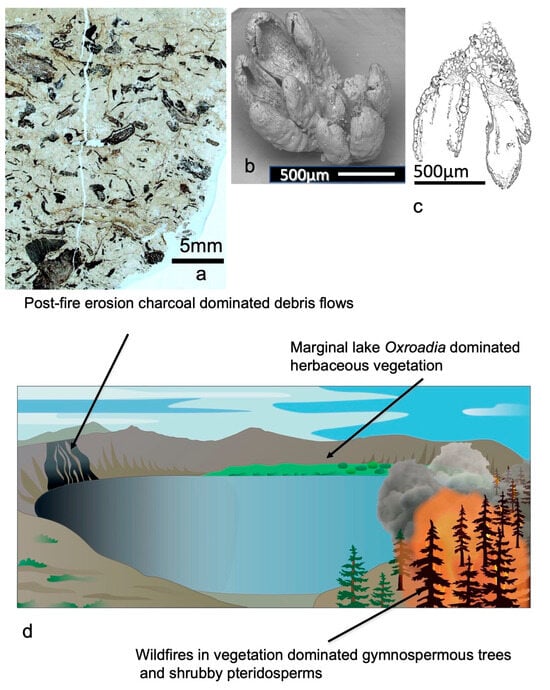
Figure 5.
The Viséan charcoal assemblage from Kingswood, Fife, Scotland (after Scott []). (a) Thin section of bedded ash with limestone matric with abundant charcoal from the Lower section (KIN). (b) SEM of new undescribed pteridosperm pollen organ with clusters of sporangia cf. Phaceotheca. (c) SRXTM section of (b). (d) Diagram showing interpretation of the Kingswood deposits as forming in a crater lake (from Scott []).
1.4. Post-Fire Erosion
One of the newly recognized features following modern wildfires [] was the occurrence of post-fire erosion and deposition [,]. It was the result of the 1988 Yellowstone fire [,] that was to prove pivotal in bringing post-fire erosion and deposition to a wider world. It had been demonstrated that rainstorms following fire could trigger extensive erosion and depositional cycles [,] and such sedimentary deposits were found within lakes within the Yellowstone area. In addition, drill cores demonstrated that such cycles had occurred numerous times [] so that by the 1990s such phenomena had become widely reported [,,]. This information had an immediate affect for the interpretation of some fossil deposits in deep time (see below).
Progress since 1994: Increasing numbers of studies, mainly in the western USA, indicated that post-fire erosion events were common in the recent record and should be visible in ancient sediments. Of particular significance was the realization that the Lower Carboniferous charcoal deposits of Donegal may have been a product of post-fire erosion/depositional processes []. Additional research in the Viséan of Western Ireland (Figure 6) indicated that this phenomenon was widespread []. Studies on later Carboniferous deposits of Nova Scotia also showed that such deposits [,,,] were a result of post-fire erosion and deposition. Yet despite such progress and the discovery of post-fire erosion deposits in, for example, the Cretaceous (see [,,], more detailed observations and interpretations of this phenomenon in the Carboniferous are needed.
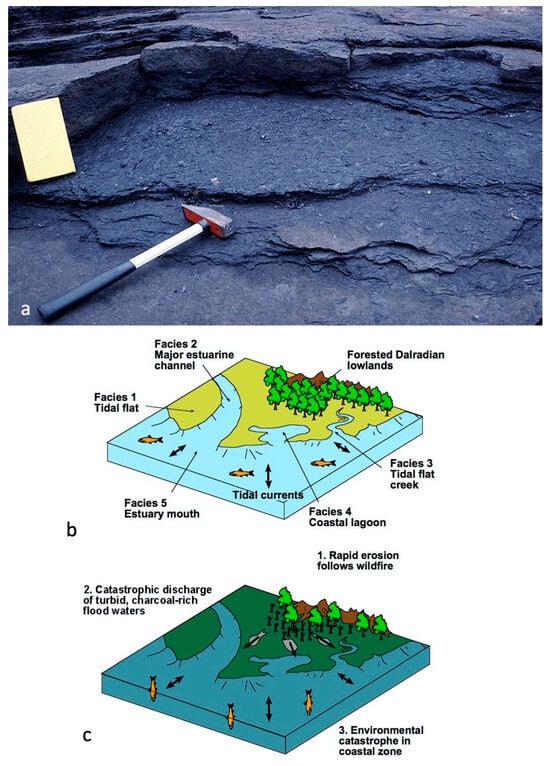
Figure 6.
The Viséan charcoal assemblage from Mayo, Ireland, and its interpretation (after Falcon-Lang []). (a) Charcoal on bedding surface of near-shore sands. (b) Carboniferous fires in Mayo—a catastrophe in the estuarine zone. (After Falcon-Lang []). Before fire. (c) Post-fire.
Experimental data: One area where progress has been made is in the understanding of the transport of charcoal and other material post-fire. This has included both laboratory and field studies. Experimental studies have included both the use of settling tanks (e.g., []), wave tanks [] and flume tanks [,,,,]). There are a few key points that need to be made. These studies showed that the temperature of formation of the charcoal plays an important role, as particularly with wood charcoals, cell wall homogenization and later break-up affects the sinking behavior of the charcoal. In addition, both plant organ type and the size of the charcoal also play a role. During water transport larger particles are likely to be carried farther and take longer to sink than smaller particles and bedload concentration is restricted to a narrow range of water speeds. The implication of these experiments are several fold. The most important in relation to fossil deposits is that if there is a range of charcoal sizes and organs, then the material cannot have undergone significant water transport and must either be near its source or have been transported by an overland slurry and not suspended in water. It is not, therefore, the case that large charcoal fragments always imply a nearby source.
Field studies: A number of field experiments and observations have been undertaken mainly in wildfire areas of coniferous forests within the Rocky Mountains. Robichaud [] undertook observations of the transport of sediment and charcoal following a series of forest fires, most notable the Hayman Fire of 2002 []. His research was, however, designed to consider treatments for preventing overland flow of the material, as were the experiments of MacDonald and Larsen []. However, the resulting trapped sediments and charcoal allowed the range of sizes and types and volume of plant material to be identified. Moody and Martin [] have demonstrated that the charcoal from fires may be trapped at various stages down through the sedimentary system. Scott et al. [] consider the effect of soil erosion [] following a wildfire as a three-part process: detachment, transport, and deposition. The erosion rates may be many times above the normal background which has implications for the recognition of such deposits in the fossil record.
The amount of charcoal from wildfires is highly variable [,]. Scott [] noted that much of the charcoal he observed in a range of wildfires was from charred litter and dead trunks rather than from the leaves of living trees that were usually totally combusted or transported in smoke (Figure 2 and Figure 3). In their reviews of pyrogenic carbon, Santin et al. [,] considered the long-term fate of such materials from the source to the oceans and Bistarelli et al. [] examined the fate of charcoal and other burned products through a river system.
1.5. Carboniferous Case Histories
In their analysis of Carboniferous wildfires, Scott and Jones [] highlighted three main study areas. Here, I will first consider the progress in our understanding of these occurrences and then consider briefly describe new data obtained in the past 30 years.
Donegal: Extensive charcoal deposits had been discovered by Scott in the late 1970s and were briefly described by Scott and Collinson []. The ability to study the charcoal by scanning electron microscopy was key to highlight the potential importance of this deposit. Scott with colleagues and his research students undertook further studies on this deposit and a detailed sedimentological analysis was undertaken by Nichols and Jones []. The charcoal-rich deposit occurred in near-shore shallow-water sands formed by a marine transgression in the early Carboniferous over a Precambrian basement in Donegal, Ireland. The mapping undertaken by Nichols and Jones [] showed that this was a very extensive unit that was deposited as a single event and they considered that it represented a major post-fire erosion–depositional event. They used limited data on charcoal production from modern wildfires to calculate an area of forest that must have burned to produce such an extent and thickness of deposit.
Another of Scott’s students, Richard Bateman, had been studying the small scrambling lycopsid from Oxroad Bay, East Lothian [], and it became apparent that one of the Donegal plants was in fact Oxroadia. Scott and Jones [] briefly reassessed the Donegal deposits.
Progress since 1994: No further studies have been undertaken on the Donegal deposits, but the nearby deposits of a similar age in Mayo have been studied by Falcon-Lang []. As indicated earlier, these studies further emphasized the impact of wildfire in the early Carboniferous and in particular the role of post-fire erosion and deposition. Here, Falcon-Lang [] was able to demonstrate that the sudden influx of fresh charcoal-rich turbid water into the estuary caused an ecological disaster, killing a large number of fish (Figure 6).
East Kirkton, Kingswood, and Pettycur: Extensive charcoal deposits, mostly connected with volcanogenic environments, were discussed in the paper []. In their study of early Carboniferous floras of Scotland, Scott and his colleagues [] had discovered a number of charcoal deposits. Limestones of Viséan age from Kingswood near Pettycur were discovered in a caravan site and were believed to be deposits of a crater lake [] (Figure 5). These limestones contained abundant charcoal fragments and whole charcoalified organs that at that time were mainly studied by using thin section of peel sections of the limestones. What the studies revealed were a large number of new genera and species of plants that were described in a series of papers and summarized by Scott and Jones [] Scott and Jones [] showed that the charcoalified plants were dominated by seed-plants that could grow in well-drained soils, whereas the uncharred Oxroadia plant probably lived near the lake shore and was not subjected to wildfire [].
The nearby Pettycur deposit of the same age as Kingswood formed in a very different way and with a completely different set of plants []. Here, the blocks of limestone and ashy limestones containing the plants were ripped up into basaltic lava flows. While some of the plants many have been charred by the hot lavas, it was evident that some plants were often charred and were found in abundance in some peat facies. This was particularly true of some of the scrambling ferns that may have been pioneers on the volcanic landscape (see [] for a discussion). Details of the charcoal occurrence and significance was not elucidated at this time.
The newly discovered flora of Mid-Late Viséan age from volcanogenic rocks at East Kirkton [] provided a different wildfire scenario. Studies undertaken through the early 1990s demonstrated the abundance of charcoal found in a hot-spring-fed lake. The charcoal was associated with pulses of reworked volcanic ash []. Charred, partially charred [], and uncharred plants (compressed and anatomically preserved permineralizations) were discovered and the plants were dominated by a range of gymnosperms [,,,,,]. Scott and Jones [] showed that the bulk of the charcoal levels were associated with alternating ash–limestone horizons that appear to indicate wildfires of the flanks of extinct ash-cone basaltic volcanoes that were vegetated and regularly burned with the material being washed in to the lake by post-fire erosion.
Progress since 1994: While there have been no further studies on the charcoals from East Kirkton, the role of wildfire in the system had been further emphasized [,] (Figure 7). However, the development of new microscopical techniques and a renewed interest in the new plants discovered at Kingswood has allowed a re-assessment of the deposit. Dissolving the limestone containing charcoal from Kingswood yielded rich charcoal assemblages [] (Figure 5). However, the disadvantage is that while the morphology of the plants could be investigated by Scanning Electron Microscopy, the internal anatomy of the plants was difficult to determine. The new technique of Synchrotron Radiation X-ray Tomographic Microscopy (SRXTM) using the Swiss Light Source has revolutionized the study of such fossils, allowing the non-destructive imaging of the internal anatomy of the charcoal (Figure 5b,c). This technique was first used to study pteridosperm fertile organs []) that led to not only the recognition of a large number of new taxa [,]) but also detailed new descriptions leading to the recognition of new genera and species of plants []. The result of this re-examination of the charcoal is to widen the taxa of plants that were subjected to fire. Further, taphonomic considerations indicate that the size range of the charcoal together with volcanic clast sizes indicate that the vegetation was subjected to wildfire followed by post-fire erosion and deposition into a crater lake [] (Figure 5d).
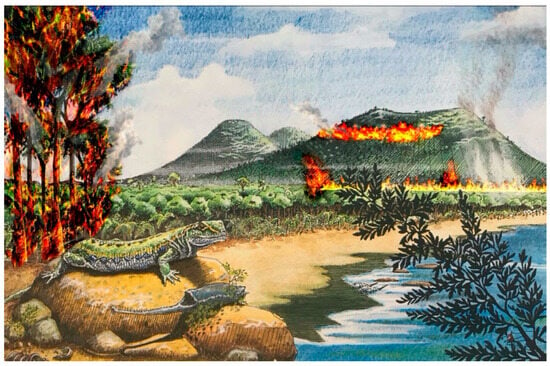
Figure 7.
The interpretation of the Viséan East Kirkton environment highlighting the role of wildfire (Modified from Clarkson et al. [], with permission from the National Museums of Scotland).
A re-assessment of the nearby Pettycur Limestone site demonstrated that some ferns were preferentially preserved as charcoal and could also be studied using Scanning Electron Microscopy [] (Figure 8). In addition, it was shown that some of the fern-dominated vegetation living on volcanic soils was prone to wildfire and some of this material was incorporated into lahar deposits and some into the peat-forming environment of the main Pettycur Limestone [].
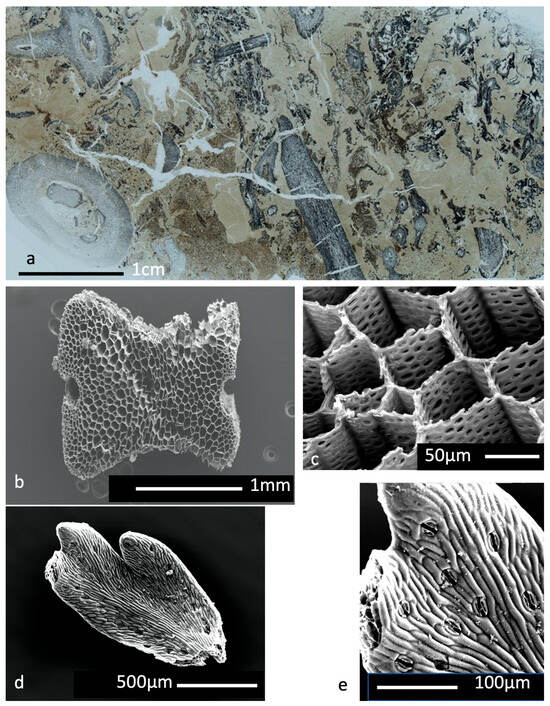
Figure 8.
Charcoal in volcanic ash lahar, Viséan, Pettycur, Scotland (after Scott []). (a) Thin section of block with predominantly charcoalified zygopterid ferns (Metaclepsydropsis). (b) Scanning Electron Micrographs of charred Metaclepsydropsis. (c) Detail of Metaclepsydropsis stele showing wall thickenings. (d) Scanning Electron Micrograph of charcoalified pteridosperm leaf dissolved from Pettycur Limestone block. (e) Detail of (d) showing stomatal surface.
Other Scottish Lower Carboniferous sites have proved significant with charcoal being found widely, including at Foulden and Edrom []. However, the charcoal occurrences at the early Carboniferous site of Burnmouth in the Scottish Borders may be the most significant []. The earliest sediments of Carboniferous age at Burnmouth are now known to be in the early Tournaisian Ballagan Formation [,]. Studies from this site have provided an insight into early Carboniferous ecosystems. The earliest Carboniferous sediments comprised coarse fluvial sediments including poorly sorted conglomerates that indicate rapid deposition. The sediments contain not only a significant fauna that includes a wide size range of tetrapods, rhizodonts, and dipnoans from tiny juveniles or small-bodied taxa up to large adults, but also more than one taxon of each group. However, in addition, the sediments contain numerous charcoal fragments that range in size from a few millimeters to a centimeter in maximum dimensions. All are woody, comprising both secondary xylem and ray cell tissue. Most of the charcoal appears to have come from small woody axes and possible larger wood from a range of arborescent pteridosperms. It was considered by Clack et al. [] that the vegetated floodplains were vegetated by shrubby and arborescent pteridosperms and that they were subject to frequent wildfires and post-fire erosion. The widespread occurrence of charcoal suggests that fire appears to have been a regular occurrence through the Mississippian of Berwickshire and across the south of Scotland and to have had an impact on both the vegetation and the landscape [,,].
Swillington and Thorpe: Scott [] described the earliest known conifer from charcoalified leaves from the Pennsylvanian of Swillington, Yorkshire. In this paper he proposed that the presence of the plant as charcoal is evidence of wildfires in the nearby uplands. This plant was later described in more detail by Scott and Chaloner [] The study of the plants was part of a larger project examining the plant ecology of the British coal measures with an emphasis on the Yorkshire coalfield [,,,]. Scott [,] reported the occurrence of other charcoalified plants from the same level at Swillington but at that time did not describe the flora in detail. As part of the project, the coal sequences were also examined both in terms of lithologies as well as studying the palynology using both microspores and megaspores [] At the nearby Thorpe Brickworks, one coal had a very distinctive fusain (charcoal) band and it was demonstrated that there was a dramatic change in the vegetation after the presumed fire.
Progress since 1994: Despite the promise of the charcoal studies from Swillington, few Upper Carboniferous charcoal deposits have been studied. Emphasis has been placed upon the occurrence of charcoal in peat-forming systems [,] but little progress has been made in the understanding of fire in such systems [,,]. However, a fresh examination using scanning electron microscopy of charcoal residues from Swillington has thrown further light on at least one wildfire system []. This new research showed that some levels contain abundant leaf charcoal, mainly from pteridosperms, in addition to wood charcoal, derived from a range of gymnosperms (Figure 9), and that most of the plants preserved were of generally low stature, most commonly shrub-like, rather than being from a forest-dominated biome, and represented a surface fire regime. Larger plants could be burned via the abundance of ladder fuels (Figure 10) as indicated by vine-like or liana-like plants (Figure 10) and suggests that the living vegetation may burn relatively easily and may be similar to a modern heathland fire [,].
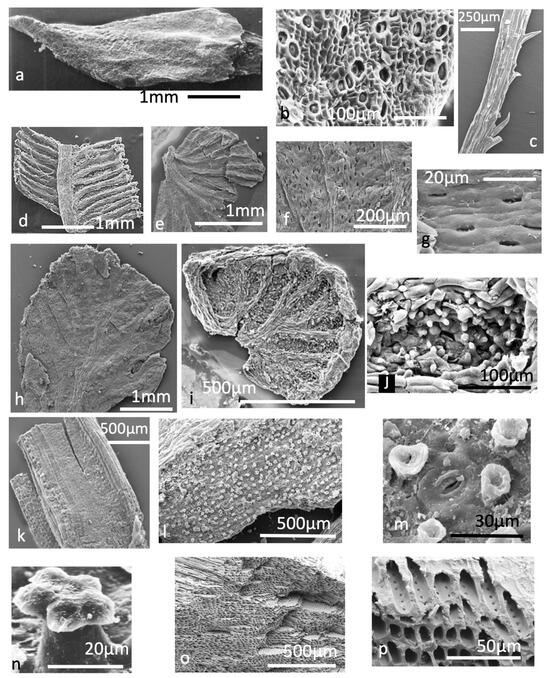
Figure 9.
Scanning Electron Micrographs of charcoal from the Westphalian (Moscovian) Coal Measures of Swillington, Yorkshire, England (after Scott []). (a) Lepidodendrid leaf cushion. (b) Stomata on (a). (c) Spiny pteridosperm axis. (d) Pteridosperm leaf (Alethopteris). (e) Pteridosperm leaf fragment. (f) Stomatal surface of (h). (g) Stomata detail of (h). (h) Pteridosperm pinnule. (i) Pteridosperm leaf (Neuropterid-like foliage). (j) Detail of (i) showing stomata and papillae. (k) Cordaite leaf fragment. (l) Cordaite leaf fragment. (m) Detail of stomataliferous area with stomata and papillate epidermal cells. (n) Distinctive papilla on Cordaite leaf with lobate top. (o) Unrushed woody fragment of Dadoxylon type. (p) Detail of (o) showing tracheids and rays.
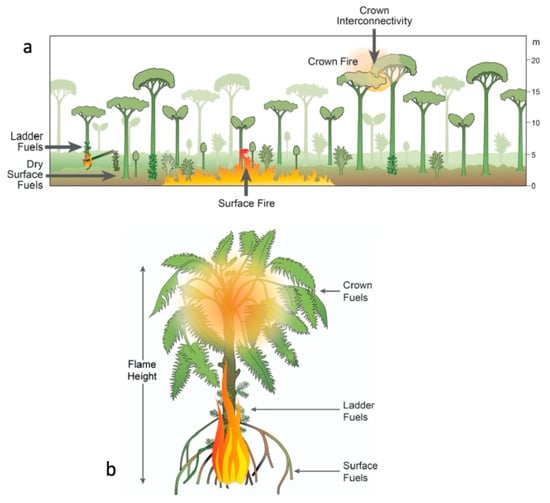
Figure 10.
Illustrations of Late Carboniferous wildfire systems. (a) A typical tropical Carboniferous ecosystem with position of fuel and fire types (from Scott []). (b) Typical Medullosan shrub with climbing liana-like plant acting as a ladder fuel to join a surface to a crown fire (from Scott []).
From these early studies up until the mid-1990s, the presence of wildfires concerned mainly their occurrence rather than providing a detailed interpretation of fire ecology. In addition to the studies on previously known localities, a number of additional studies across the world have allowed more detailed analysis of Carboniferous wildfires to be considered. Here, I shall consider two major wildfire systems from North America that illustrate our progress in their understanding and interpretation.
Joggins, Nova Scotia, Canada. The Pennsylvanian deposits at Joggins, Nova Scotia, Canada, have long been an important site for the study of Carboniferous terrestrial ecosystems (see Scott [] for a discussion of its history). It is particularly well known for its sequence of upright lycopsid trees, some of which are filled with sediments and include remains of small tetrapods [] (Figure 11). It was discovered that the vertebrates were found in the base of the trunks at some stratigraphic levels and that they were associated with charcoal (Figure 11a). It was suggested that fire may not only have played a role in hollowing out of some of the trunks (Figure 11b,c) but also provided an escape route from the frequent fires, which in some cases led to the death of the animals [] (Figure 11d).
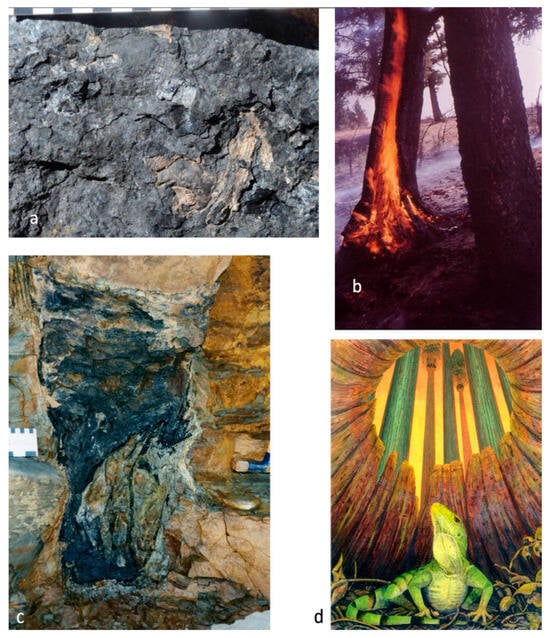
Figure 11.
Charcoal and tetrapods and their interpretation, Pennsylvanian, Joggins, Nova Scotia, Canada. (a) Charcoal and tetrapod bones from inside of hollow lycopsid trunk. (b) Tree with fire burning on one side creating a fire hollow. (c) Section through Joggins lycopsid tree with charcoal-rich sediments at base and fire-formed entrance to side of trunk. (d) Hylonomus hiding inside hollow trunk from passing wildfire (from Scott []).
Further studies on the charcoal distribution in the Joggins sequence led Falcon-Lang [,] to demonstrate a wide role for fire within a range of ecosystems and also the possibility of wildfire within cordaite-tree-dominated uplands that burned and underwent post-fire erosion [,]. In addition, studies on charcoals in varved lake sediments by Falcon-Lang [] estimated fire return intervals between 3–35 years within well-drained areas and every 105–1085 years in peat-forming systems.
Central Quarry Caves, Illinois, USA. The role of wildfire in coniferous uplands was the theme of the original publication of proposed charcoalified conifer leaves from the Pennsylvanian of Yorkshire [,]), a position strengthened by the discovery of early conifers associated with dryland facies in central England []. However, it was the discovery of early Pennsylvanian cave deposits that has shone a light upon extra-basinal deposits and wildfires (see [,]). On the northern edge of the Illinois Basin, extensive Ordovician limestones are extensively quarried. Within these limestones, a series of caves were discovered that contained early Pennsylvanian sediments that contained uncompressed and unaltered plants and animals. Of particular interest was the occurrence of two distinct charcoal assemblages. A lower assemblage was associated with uncharred peat-forming plants and included a range of plants including lycopsids, ferns, pteridosperms, and cordaites; and an upper unit comprised exclusively charcoalified coniferous remains, some of the earliest known from North America. In addition to the charcoal studies, geochemical studies were undertaken. The lipid extract of the cave-fill sequence contains polyaromatic hydrocarbons (PAHs), such as pyrene, chrysene, benzo [ghi]perylene, and coronene (Figure 12 and Figure 13). These demonstrated the frequent occurrence of fire, even when no associated charcoal deposits were present []. The implications of fires through coniferous forests are discussed further below under plant traits.
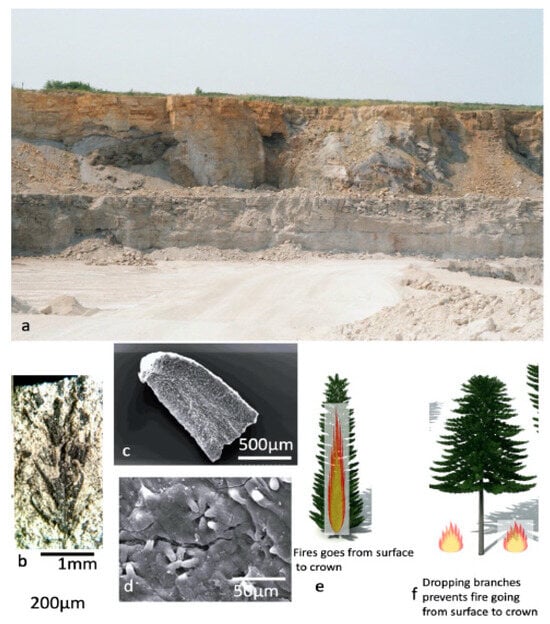
Figure 12.
Charcoal occurrence in Pennsylvanian caves in Ordovician Limestone, Central Quarry, Illinois (after Scott et al. []). (a) Main Quarry wall with caves. (b–d) Charred conifers from the upper cave sediments (facies D), Central Quarry, Illinois. (b) Ultimate branch with leaves. (c) Isolated leaf with curved tip. (d) Detail of (c) showing stomatal bands. (e) Representation of Walchia conifer with lower branches acting as a ladder fuel. (f) Walchia with lower branches abscised preventing migration of fire.
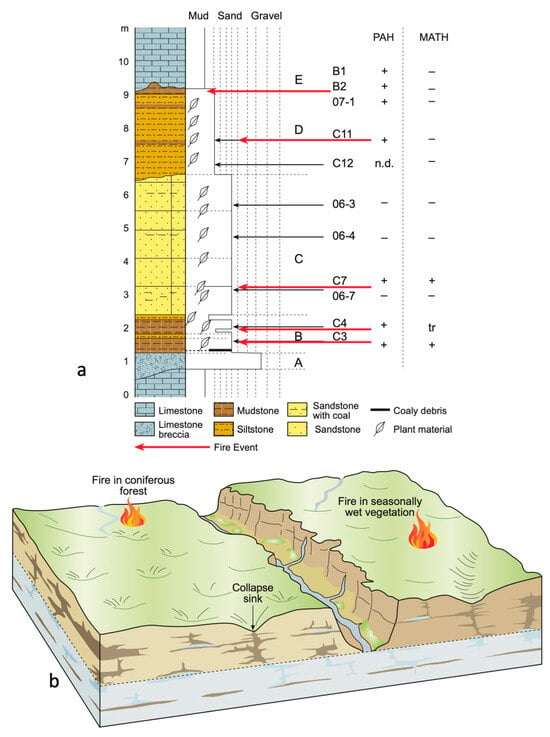
Figure 13.
Charcoal occurrence in Pennsylvanian caves in Ordovician Limestone, Central Quarry, Illinois (after Scott et al. []). (a) Sedimentological sequence in the large cave, Central Quarry, Illinois. Lithological log of sedimentary sequence. PAHs refer to polyaromatic hydrocarbons. MATH refers to biomarkers of Cordaites. + present; ! absent; n.d. not determined; tr trace. (b) Reconstruction of Pennsylvania cave system outside the Illinois Basin showing wildfires.
What should not be forgotten is the occurrence of fires in Carboniferous peat-forming mires (coals). Scott []) briefly discussed this issue and observed that the identification of charcoalified plants in permineralized peats (coal balls) may be key for our understanding of these systems. Recent digitization of a substantial coal ball peel collection studied over many decades by Tom Phillips now offers the opportunity to obtain data in the future [].
It should be noted here that only a few other Carboniferous charcoal assemblages have been described from outside Euramerica (see [,,]) and this has been recently highlighted by Uhl et al. [].
1.6. Wildfire, Climate, and Atmosphere with Plant Trait Evolution
Since 1994, there have been many other developments in our understanding of both modern and ancient wildfires.
1.6.1. Fire and Atmospheric Oxygen
In 1978, Watson and colleagues published a paper that considered the burning of plants in different concentrations of atmospheric oxygen []. They were able to show that there was a limit to burning. In particular, they showed that as the level of oxygen reduced from today’s level of 21%, fire was becoming more difficult to start and at 13%, fire would not start at all. In addition, they showed that as the level of oxygen was raised above 21%, wetter and wetter plants could burn and suggested that at over 35% atmospheric oxygen, fires would be difficult to extinguish. Cope and Chaloner [,] realized that this had implications for the fossil record. They [] that the ubiquitous occurrence of charcoal throughout the late Paleozoic to recent eras indicated that oxygen levels would have remained over 13%. Jones and Chaloner [] further argued that there was, therefore, a ‘fire window’ which was not breached after the Devonian. Subsequently, there have been two major developments. New atmospheric models of oxygen through time by Berner [,,]) claimed that there was a major rise in oxygen from the Devonian through the Carboniferous. In addition, new experiments seemed to indicate that the minimum oxygen level was higher, perhaps 15% []. Scott and Glasspool []) subsequently considered the impact that this had upon Carboniferous ecosystems as a whole. Refinement using new experiments on the fire window was undertaken by Belcher and McElwain [,]. They showed that the lower limit of oxygen would have been 17% as this represented the level at which wildfires would spread. In addition, they argued that fires may not have been possible at levels above 30% oxygen.
The rise of wildfire systems from the Devonian to the Carboniferous had always been controversial [], but new data demonstrated that oxygen levels rose through the latest Devonian, and by the Carboniferous, wildfire systems had become well established []. The major problem has always been that atmospheric oxygen levels were calculated from a range of geochemical models that would differ depending on a number of core assumptions (e.g., [,,,,]). Glasspool and Scott [] tried a different approach. They noted the new data from Belcher and McElwain [] but also noted that fires were often constrained by climatic effects so that they occurred more rarely in wetland ecosystems. In addition, if higher oxygen levels allowed fires in wetter environments, these data could be exploited. Glasspool and Scott [] considered, therefore, that the occurrence of charcoal in peat could act as an oxygen proxy through time (Figure 14). They noted that coals (peats accumulating in wetland mires []) needed to form in ever-wet environments where the occurrence of fire, although occurring on occasions, would generally be low. They noted that the average charcoal contents globally in peats today was around 4.7% with an atmosphere of 21% oxygen. They also noted that at below 17% atmospheric oxygen, fire would not spread, so this acts as a bottom limit. In addition, at above 30–35% oxygen, fires may burn wet plants so that this may act as an upper limit of oxygen content as fires would be difficult to extinguish. It was also at this time that land plants diversified and spread into a wider range of environments (Figure 14). Glasspool and Scott [] used these data to propose an oxygen level through post-Devonian times and confirmed high oxygen levels in the Carboniferous. Indeed, analysis of the latest Devonian charcoals was able to confirm the rise of fire as a major influence into the early Carboniferous []. Additional data and a more refined analysis [] confirmed these findings (Figure 14). While some of this analysis has been challenged [], all models suggest a high level of oxygen, above the modern level of 21%, throughout the Carboniferous.
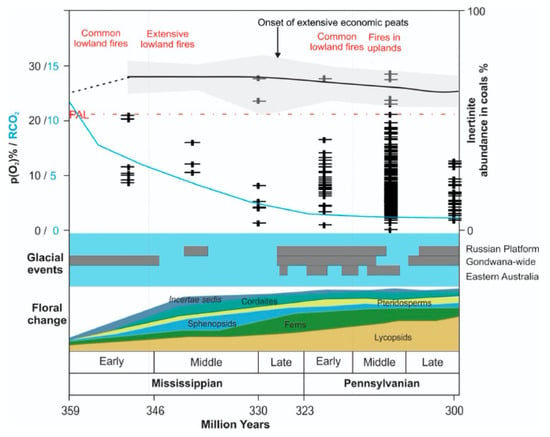
Figure 14.
The evolution of Carboniferous vegetation, climate, and atmospheric oxygen levels (data from Glasspool et al. []—Diagram I. Glasspool).
1.6.2. Wildfire and Climate
There has been a widespread belief that global climates underwent a major shift from the Devonian to the Carboniferous with the widespread occurrence of red beds in the later Devonian giving rise to wetter systems in the early Carboniferous [,]. It has even been claimed that some of these climate systems were monsoonal [,]). However, not only were there major changes in climates at the end of the Devonian but also a rise in atmospheric oxygen led to a diversification of fire systems at this time []). The succeeding Carboniferous reflects a tension between the atmospheric control of wildfire and the climate control of wildfire [] (Figure 15). It is also worth considering that the Earth enters a major Icehouse phase with a series of glacial and inter-glacial episodes [,] (Figure 14 and Figure 15). However, recent research has also shown that in the Pennsylvanian in particular, the common coal-bearing sequences represent only part of the time (see [,]). DiMichele, Falcon-Lang et al. [,] have highlighted the fact that the drier non-coal-forming environments are poorly represented in the rock record so that our understanding of wildfires at this time is rather limited to only a few environmental settings. We urgently need to discover more sequences representing this drier phases and the cave systems may provide such an opportunity [].
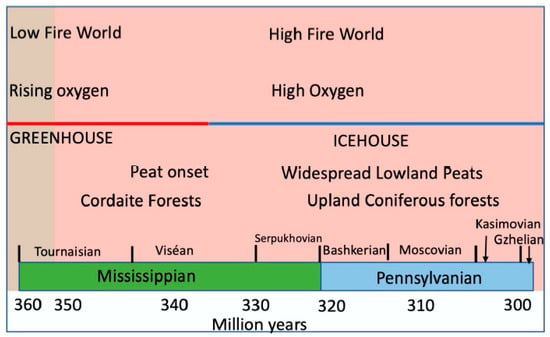
Figure 15.
Events in the Carboniferous Earth System (see text for discussion).
1.6.3. Evolution of Plant Traits
An area of current interest is the evolution of plant traits, especially in relation to wildfire [,,,]. It has been shown that a combination of fossil and molecular data from the Cretaceous, for example, has proven a powerful tool in unraveling cause and effect of the evolution of some of the fire traits considered important in modern vegetation (see for example [,,,,,,].
However, studies in the Carboniferous are more difficult as most of the plants do not have close living relatives and such molecular/anatomical approaches are more difficult. Ferns, for example, are often associated with burned and disturbed environments even in the Carboniferous [,] (Figure 8a-c). However, one suggestion of a trait that may relate to fire comes from the early conifers. Looy [] has considered the early walchian conifers shed their lower branches. It was suggested that this may be a response to fire, whereby the trees would be able to survive frequent surface fires as there would be no ladder fuels to allow the spread of the fires to the crowns of the trees [] (Figure 12e,f). It is particular interesting the note that charred walchian coniferous leaf debris is common in the cave deposits that record evidence of wildfires in upland coniferous forests [] (Figure 12).
2. Conclusions
The past 30 years has seen not only more data published on Carboniferous wildfires but also a broader range of questions asked and discussed. We have learned much about the rise and spread of fire systems in the early Carboniferous and the linkage to the evolution of the flora as well as the rise of atmospheric oxygen (Figure 14 and Figure 15). Of particular significance is the realization that more plants can be discovered as charcoal and that a range of new microscopical techniques has allowed their study and interpretation. The role of wildfire-related processes, such as post-fire erosion and deposition, has been highlighted. However, what the current review reveals is the range of data needed from both modern and ancient wildfire studies to allow a more considered view of fire in the Carboniferous Earth System.
What we need to know from modern wildfire studies is as follows: Despite the large number of studies on modern wildfires, there have been very few studies on the “ash” produced from different types of wildfire. There is a general understanding on the nature of some ashes but we lack a detailed understanding on the plants and plant parts that are preserved as charcoal from a wildfire. We need to know that plants and plant parts may be preserved not only by different types of wildfire but also by fires of different intensities. In addition, it would be useful to know not only the relationship between the living vegetation and the charcoal-preserved vegetation following a fire. What is the relative representation in the charcoal between surface vegetation and forest vegetation? How does the charcoal from grasslands differ from heathlands, open woodlands, etc.?
Secondly, we need to know how assemblages of charcoal change through transport and deposition, again not only from the sizes and amounts of charcoal but from the representation of the vegetation—is wood charcoal more likely to be preserved than charcoal of other plant organs?
What we need to know from fossil wildfire studies is as follows: We need many more studies of Carboniferous charcoal assemblages both throughout the geological column and across different continents. It is difficult to understand why there are so few studies. It is possible that the amount of work needed to find, prepare, pick, and study such small plants is off-putting to researchers more interested in ‘big data’ studies. It is hoped that the illustration of small charcoalified fossils by a range of new techniques may encourage such studies so that continued progress may be made in our understanding of Carboniferous wildfire systems and to fully integrate fire into models of the Carboniferous Earth System.
Funding
This research received no external funding
Acknowledgments
Much of the development of my ideas on ancient wildfire systems has been helped by the interest of my colleagues at Royal Holloway, especially Margaret Collinson, Bill Chaloner, and Gary Nichols. Technical help from Sharron Gibbins, Lynne Blything, Kevin d’Souza, Keith Stephens and Neil Holloway has been particularly invaluable as have many of my former research students and assistants including Kate Bartram, Richard Bateman, Rachel Brown, Tim Jones, Jenny Cripps, Ian Glasspool, Howard Falcon-Lang, Claire Belcher, Laura McParland, David Steart, Sarah Brown, Vicky Hudspith, Brittany Robson, and Mark Hardiman. My studies on modern and fossil charcoal have benefited from collaborations with Michael Bird, Phillipa Ascough, Roy Plotnick, and Fabien Kenig. My studies on modern wildfires benefited from advice and field help from Deborah Martin, John Moody, Chris Roos, Scott Anderson, Artemi Cerda, and Pete Robichaud. An invitation to join the Pyrogeography working group by David Bowman and Jennifer Balch transformed my understanding on modern wildfires and led to collaborations with Stephen Pyne, William Bond, and Chris Roos in particular.
Conflicts of Interest
The author declares no conflict of interest.
References
- Harris, T.M. Forest fire in the Mesozoic. J. Ecol. 1958, 46, 447–453. [Google Scholar] [CrossRef]
- Harris, T.M. A Liasso-Rhaetic flora in South Wales. Proc. R. Soc. Lond. Ser. B 1957, 147, 289–308. [Google Scholar]
- Stopes, M.C. On the four visible ingredients in banded bituminous coal. Proc. R. Soc. Ser. B 1919, 90, 470–487. [Google Scholar]
- Schopf, J.M. Modes of fossil preservation. Rev. Palaeobot. Palynol. 1975, 20, 27–53. [Google Scholar] [CrossRef]
- Scott, A.C. Observations on the nature and origin of fusain. Int. J. Coal Geol. 1989, 12, 443–475. [Google Scholar] [CrossRef]
- Scott, A. The earliest conifer. Nature 1974, 251, 707–708. [Google Scholar] [CrossRef]
- Teichmüller, M. Origin of the petrographic constituents of coal. In Stach’s Textbook of Coal Petrology, 2nd ed.; Stach, E., Mackowsky, M.-T., Teichmiiller, M., Taylor, G.H., Chandra, D., Teichmüller, R., Eds.; Gebrüder Borntraeger: Berlin, Germany, 1975; pp. 176–238. [Google Scholar]
- Teichmüller, M. The genesis of coal from the viewpoint of coal petrology. Int. J. Coal Geol. 1989, 12, 1–87. [Google Scholar] [CrossRef]
- Scott, A.C.; Collinson, M.E. Organic sedimentary particles: Results from Scanning Electron Microscope studies of fragmentary plant material. In Scanning Electron Microscopy in the Studies of Sediments; Whalley, W.B., Ed.; Geoabstracts: Norwich, UK, 1978; pp. 137–167. [Google Scholar]
- Cope, M.J. Products of natural burning as a component of the dispersed organic matter of sedimentary rocks. In Organic Maturation Studies and Fossil Fuel Exploration; Brooks, J., Ed.; Academic Press: London, UK, 1981; pp. 89–109. [Google Scholar]
- Cope, M.J.; Chaloner, W.G. Fossil charcoal as evidence of past atmospheric composition. Nature 1980, 283, 647–649. [Google Scholar] [CrossRef]
- Cope, M.J.; Chaloner, W.G. Wildfire, an interaction of biological and physical processes. In Geological Factors and the Evolution of Plants; Tiffney, B.H., Ed.; Yale University Press: Hartford, CT, USA, 1985; pp. 257–277. [Google Scholar]
- Jones, T.P.; Chaloner, W.G. Fossil charcoal, its recognition and palaeoatmospheric significance. Palaeogeogr. Palaeoclimatol. Palaeoecol. 1991, 97, 39–50. [Google Scholar] [CrossRef]
- Jones, T.P.; Scott, A.C.; Cope, M. Reflectance measurements and temperature of formation of modern charcoals and implications for studies of fusain. Bull. De La Société Géologique De Fr. 1991, 162, 193–200. [Google Scholar]
- Nichols, G.; Jones, T.P. Fusain in Carboniferous shallow marine sediments, Donegal, Ireland: The sedimentological effects of wildfire. Sedimentology 1992, 39, 487–502. [Google Scholar] [CrossRef]
- Scott, A.C. Environmental Control of Westphalian Plant Assemblages from Northern Britain. Ph.D. Thesis, University of London, London, UK, 1976. Volume 2. 383p. [Google Scholar]
- Scott, A.C. A review of the ecology of Upper Carboniferous plant assemblages with new data from Strathclyde. Palaeontology 1977, 20, 447–473. [Google Scholar]
- Scott, A.C. The ecology of Coal Measure Floras from Northern Britain. Proc. Geol. Assoc. 1979, 90, 97–116. [Google Scholar] [CrossRef]
- Scott, A.C.; Jones, T.P. Microscopical observations of Recent and fossil charcoal. Microsc. Anal. 1991, 25, 13–15. [Google Scholar]
- Scott, A.C.; Jones, T.J. The nature and influence of fires in Carboniferous ecosystems. Palaeogeogr. Palaeoclimatol. Palaeoecol. 1994, 106, 91–112. [Google Scholar] [CrossRef]
- Ahlgren, C.E. Introduction. In Fire and Ecosystems; Kozolwski, T.T., Ahlgren, C.E., Eds.; Academic Press: New York, NY, USA, 1974; pp. 1–5. [Google Scholar]
- Cohen, A.D. Evidence of fires in the ancient Everglades and coastal swamps of Southern Florida. In Environments of South Florida, Present and Past, Miami Geological Society Memoir; Miami Geological Society: Miami, FL, USA, 1974; pp. 213–218. [Google Scholar]
- Davis, K.P. Forest Fire—Control and Use; McGraw-Hill: New York, NY, USA, 1959; 584p. [Google Scholar]
- Rundel, P.W. Fire as an ecological factor. In Physiological Plant Ecology I. Response to the Physical Environment; Lange, O.L., Nobel, P.S., Osmond, C.B., Ziegler, H., Eds.; Springer: Berlin/Hiedelberg, Germany, 1981; pp. 501–538. [Google Scholar]
- Scott, D.F.; Curran, M.P.; Robichaud, P.R.; Wagenbrenner, J.W. Soil erosion after forest fire. In Fire Effects on Soils and Restoration Strategies; Cerdà, A., Robichaud, P., Eds.; Science Publishers Inc.: Enfield, NH, USA, 2009; pp. 179–196. [Google Scholar]
- Scott, A.C. The Pre-Quaternary History of Fire. Palaeogeogr. Palaeoclimatol. Palaeoecol. 2000, 164, 281–329. [Google Scholar] [CrossRef]
- Scott, A.C.; Glasspool, I.J. The diversification of Paleozoic fire systems and fluctuations in atmospheric oxygen concentration. Proc. Natl. Acad. Sci. USA 2006, 103, 10861–10865. [Google Scholar] [CrossRef] [PubMed]
- Bowman, D.M.J.S.; Balch, J.K.; Artaxo, P.; Bond, W.J.; Carlson, J.M.; Cochrane, M.A.; D’Antonio, C.M.; DeFries, R.S.; Doyle, J.C.; Harrison, S.P.; et al. Fire in the Earth System. Science 2009, 324, 481–484. [Google Scholar] [CrossRef] [PubMed]
- Scott, A.C.; Bowman, D.J.M.S.; Bond, W.J.; Pyne, S.J.; Alexander, M. Fire on Earth: An Introduction; John Wiley and Sons: Chichester, UK, 2014; 413p. [Google Scholar]
- Scott, A.C. Preservation by fire. In Palaeobiology II; Briggs, D.E.G., Crowther, P.R., Eds.; Blackwell Science: Oxford, UK, 2001; pp. 277–280. [Google Scholar]
- Komarek, E.V. Ancient fires. Proc. Annu. Tall Timbers Fire Ecol. Conf. 1972, 12, 219–240. [Google Scholar]
- Komarek, E.V.; Komarek, B.B.; Carlysle, T.C. The Ecology of Smoke Particulates and Charcoal Residue from Forest and Grassland Fires: A Preliminary Atlas; Miscellaneous Publication 3; Tall Timbers Research Station: Tallahassee, FL, USA, 1973. [Google Scholar]
- Griffin, J.J.; Goldberg, E.D. Morphologies and origin of elemental carbon in the environment. Science 1979, 206, 563–565. [Google Scholar] [CrossRef] [PubMed]
- Patterson, W.A., III; Edwards, K.J.; Maguire, D.J. Microscopic charcoals as a fossil indicator of fire. Quat. Sci. Rev. 1987, 6, 13–23. [Google Scholar] [CrossRef]
- Clark, J.S. Particle motion and the theory of charcoal analysis: Source area, transport, deposition and sampling. Quat. Res. 1988, 30, 67–80. [Google Scholar] [CrossRef]
- Clark, J.S.; Patterson, W.A., III. Background and local charcoal in sediments: Scales of fire evidence in the palaeo record. In Sediment Records of Biomass Burning and Global Change; Clark, J.S., Cachier, H., Goldammer, J.G., Stocks, B., Eds.; NATO ASI Series (ASI I); Springer: Berlin/Hiedelberg, Germany, 1997; Volume 51, pp. 23–48. [Google Scholar]
- Clark, J.S.; Robinson, J. Palaeoecology of fire. In Fire in the Environment: The Ecological, Atmospheric and Climatic Importance of Vegetation Fires; Crutzen, P.J., Goldammer, J.G., Eds.; Dahlem Workshop Reports; Environmental Science Research Reports No. 13; Wiley: Chichester, UK, 1993; pp. 193–214. [Google Scholar]
- Despain, D.; Rodman, A.; Schullery, P.; Shovic, H. Burned Area Survey of Yellowstone National Park: The Fires of 1988; US. Department of the Interior, National Park Service: Yellowstone National Park, WY, USA, 1989; 14p. [Google Scholar]
- Meyer, G.A.; Pierce, J.L. Climatic controls on fire-induced sediment pulses in Yellowstone National Park and central Idaho: A long-term perspective. For. Ecol. Manag. 2003, 178, 89–104. [Google Scholar] [CrossRef]
- Meyer, G.A.; Wells, S.G.; Bailing, R.C.; Jull, A.J.T. Response of alluvial systems to fire and climate change in Yellowstone National Park. Nature 1992, 357, 147–150. [Google Scholar] [CrossRef]
- Wuerthner, G. Yellowstone and the Fires of Change; Haggis House Publications: Salt Lake City, UT, USA, 1988. [Google Scholar]
- Scott, A.C.; Cripps, J.A.; Nichols, G.J.; Collinson, M.E. The taphonomy of charcoal following a recent heathland fire and some implications for the Interpretation of fossil charcoal deposits. Palaeogeogr. Palaeoclimatol. Palaeoecol. 2000, 164, 1–31. [Google Scholar] [CrossRef]
- Scott, A.C. Forest Fire in the Fossil Record. In Fire Effects on Soils and Restoration Strategies; Cerdà, A., Robichaud, P., Eds.; Science Publishers Inc.: Enfield, NH, USA, 2009; pp. 1–37. [Google Scholar]
- Scott, A.C. Charcoal recognition, taphonomy and uses in palaeoenvironmental analysis. Palaeogeogr. Palaeoclimatol. Palaeoecol. 2010, 291, 11–39. [Google Scholar] [CrossRef]
- Belcher, C.M.; New, S.L.; Santín, C.; Doerr, S.H.; Dewhirst, R.A.; Grosvenor, M.J.; Hudspith, V.A. What Can Charcoal Reflectance Tell Us About Energy Release in Wildfires and the Properties of Pyrogenic Carbon? Front. Earth Sci. 2018, 6, 169. [Google Scholar] [CrossRef]
- Hudspith, V.A.; Hadden, R.M.; Bartlett, A.I.; Belcher, C.M. Does fuel type influence the amount of charcoal produced in wildfires? Implications for the fossil record. Palaeontology 2017, 61, 159–171. [Google Scholar] [CrossRef]
- Santín, C.; Doerr, S.H.; Shakesby, R.A.; Bryant, R.; Sheridan, G.J.; Lane, P.N.J.; Smith, H.G.; Bell, T.L. Carbon loads, forms and sequestration potential within ash deposits produced by wildfire: New insights from the 2009 ‘Black Saturday’ fires, Australia. Eur. J. For. Res. 2012, 131, 1245–1253. [Google Scholar] [CrossRef]
- Scott, A.C. Burning Planet. The Story of Fire through Time; Oxford University Press: Oxford, UK, 2018; 224p, ISBN 978-0-19-873484-0. (In Spanish and Japanese). [Google Scholar]
- Scott, A.C. Fire: A Very Short Introduction; Oxford University Press: Oxford, UK, 2020; 156p. [Google Scholar]
- Scott, A.C. Charcoalified vegetation from the Pennsylvanian of Yorkshire, England: Implications for the interpretation of Carboniferous wildfires. Rev. Palaeobot. Palynol. 2022, 296, 104540. [Google Scholar] [CrossRef]
- Scott, A.C.; Collinson, M.E. A note on the charring of spores and implications for coal petrographic analysis. Int. J. Coal Geol. 2020, 219, 103361. [Google Scholar] [CrossRef]
- Correia, M.; Maury, R.; Arai, F. Mesure par leur pouvoir re’flecteur, des temperatures de carbonisation des bois fossilise’s dans les formations volcanique. Bull. Du Cent. De Rech. De Pau 1974, 8, 527–536. [Google Scholar]
- Brown, R.E.; Scott, A.C.; Jones, T.P. Taphonomy of fossil plants from the Viséan of East Kirkton, West Lothian, Scotland. Trans. R. Soc. Edinb. Earth Sci. 1994, 84, 267–274. [Google Scholar] [CrossRef]
- Scott, A.C. Preservation, evolution and extinction of plants in Lower Carboniferous volcanic sequences in Scotland. In Volcanism and Fossil Biotas; Lockley, M.G., Rice, A., Eds.; Geological Society of America Special Publication: Boulder, CO, USA, 1990; Volume 244, pp. 25–38. [Google Scholar]
- Scott, A.C.; Glasspool, I.J. Charcoal reflectance as a proxy for the emplacement temperature of pyroclastic flow deposits. Geology 2005, 33, 589–592. [Google Scholar] [CrossRef]
- Bull, I.D.; Knicker, H.; Poirier, N.; Porter, H.C.; Scott, A.C.; Sparks, R.S.J.; Evershed, R.P. Biomolecular characteristics of an extensive tar layer generated during eruption of the Soufrière Hills volcano, Montserrat, West Indies. Org. Geochem. 2008, 39, 1372–1383. [Google Scholar] [CrossRef]
- Scott, A.C.; Sparks, R.S.J.; Bull, I.D.; Knicker, H.; Evershed, R.P. Temperature proxy data and their significance for the understanding of pyroclastic density currents. Geology 2008, 36, 143–146. [Google Scholar] [CrossRef]
- Hudspith, V.A.; Scott, A.C.; Wilson, C.J.N.; Collinson, M.E. Charring of woods by volcanic processes: An example from the Taupo Ignimbrite, New Zealand. Palaeogeogr. Palaeoclimatol. Palaeoecol. 2010, 291, 40–51. [Google Scholar] [CrossRef]
- McParland, L.C.; Collinson, M.E.; Scott, A.C.; Steart, D.C.; Grassineau, N.J.; Gibbons, S.J. Ferns and fires: Experimental charring of ferns compared to wood and implications for paleobiology, paleoecology, coal petrology, and isotope geochemistry. Palaios 2007, 22, 528–538. [Google Scholar] [CrossRef]
- Scott, A.C.; Glasspool, I.J. Observations and experiments on the origin and formation of inertinite group macerals. Int. J. Coal Geol. 2007, 70, 53–66. [Google Scholar] [CrossRef]
- McParland, L.C.; Collinson, M.E.; Scott, A.C.; Campbell, G. The use of reflectance values for the interpretation of natural and anthropogenic charcoal assemblages. Archaeol. Anthropol. Sci. 2009, 1, 249–261. [Google Scholar] [CrossRef][Green Version]
- Belcher, C.M.; Hudspith, V.A. The formation of charcoal reflectance and its potential use in post-fire assessments. Int. J. Wildland Fire 2016, 25, 775–779. [Google Scholar] [CrossRef]
- Belcher, C.M.; New, S.L.; Gallagher, M.R.; Grosvenor, M.J.; Clark, K.; Skowronski, N.S. Bark charcoal reflectance may have the potential to estimate the heat delivered to tree boles by wildland fires. Int. J. Wildland Fire 2021, 30, 391–397. [Google Scholar] [CrossRef]
- Roos, C.I.; Scott, A.C. A Comparison of Charcoal Reflectance between Crown and Surface Fire Contexts in Dry Southwest US Forests. Int. J. Wildland Fire 2018, 27, 396–406. [Google Scholar] [CrossRef]
- Theurer, T.; Naszarkowski, N.; Muirhead, D.K.; Jolley, D.; Mauquoy, D. Assessing Modern Calluna Heathland Fire Temperatures Using Raman Spectroscopy: Implications for Past Regimes and Geothermometry. Front. Earth Sci. 2022, 10, 827933. [Google Scholar] [CrossRef]
- Friis, E.M. Preliminary report of Upper Cetaceous angiosperm reproductive organs from Sweden and their level of organization. Ann. Mo. Bot. Gard. 1984, 71, 403–418. [Google Scholar] [CrossRef]
- Pearson, A.; Scott, A.C. Large palynomorphs and debris. In Fossil Plants and Spores: Modern Techniques; Jones, T.P., Rowe, N.P., Eds.; Geological Society: London, UK, 1999; pp. 20–25. [Google Scholar]
- Herendeen, P.S.; Magallon-Puebla, S.; Lupia, R.; Crane, P.R.; Kobylinska, J. A preliminary conspectus of the Allon flora from the Late Cretaceous (Late Santonian) of the central Georgia, USA. Ann. Mo. Bot. Gard. 1999, 86, 407–471. [Google Scholar] [CrossRef]
- Friis, E.M.; Crane, P.R.; Pedersen, K.P.; Bengtson, S.; Donoghue, P.C.J.; Grimm, G.W.; Stampanoni, M. Phase- contrast X-ray microtomography links Cretaceous seeds with Gnetales and Bennettitales. Nature 2007, 450, 549–552. [Google Scholar] [CrossRef] [PubMed]
- Scott, A.C.; Galtier, J.; Gostling, N.J.; Smith, S.Y.; Collinson, M.E.; Stampanoni, M.; Marone, F.; Donoghue, P.C.J.; Bengtson, S. Scanning Electron Microscopy and Synchrotron Radiation X-ray Tomographic Microscopy of 330 million year old charcoalified seed fern fertile organs. Microsc. Microanal. 2009, 15, 166–173. [Google Scholar] [CrossRef] [PubMed]
- Scott, A.C.; Hilton, J.; Galtier, J.; Stampanoni, M. A charcoalified ovule adapted for wind dispersal and deterring herbivory from the Late Viséan (Carboniferous) of Scotland. Int. J. Plant Sci. 2019, 180, 1059–1074. [Google Scholar] [CrossRef]
- Scott, A.C. Carboniferous wildfire revisited: Wildfire, post-fire erosion and deposition in a Mississippian crater lake. Proc. Geol. Assoc. 2024, in press. [Google Scholar]
- Swanson, F.J. Fire and geomorphic processes. In Fire Regimes and Ecosystem Properties; Mooney, H.A., Bonnicksen, T.H., Christensen, N.L., Lotan, J.E., Reiners, W.A., Eds.; USDA Forestry Service General Technical Report WO-26; USDA Forestry Service: Washinghton, DC, USA, 1981; pp. 401–420. [Google Scholar]
- Cannon, S.H. Debris flow generation from recently burned watersheds. Environ. Eng. Geosci. 2001, 7, 321–341. [Google Scholar] [CrossRef]
- Pierce, J.L.; Meyer, G.A.; Jull, A.J.T. Fire induced erosion and millennial-scale climate change in northern Ponderosa pine forests. Nature 2004, 432, 87–90. [Google Scholar] [CrossRef] [PubMed]
- Moody, J.A.; Martin, D.A. Initial hydrologic and geomorphic response following a wildfire in the Colorado Front Range. Earth Surf. Process Landf. 2001, 26, 1049–1070. [Google Scholar] [CrossRef]
- Moody, J.A.; Martin, D.A. Wildfire impacts on reservoir sedimentation in the western United States. In Proceedings of the Ninth International Symposium on River Sedimentation, Yichang, China, 18–21 October 2004; Tsinghua University Press: Beijing, China, 2004; pp. 1095–1102. [Google Scholar]
- Moody, J.A.; Martin, D.A. Forest fire effects on geomorphic processes. In Fire Effects on Soils and Restoration Strategies; Cerda, A., Robichaud, P., Eds.; Science Publishers, Inc.: Enfield, NH, USA, 2009; pp. 41–79. [Google Scholar]
- Falcon-Lang, H.J. The impact of wildfire on an Early Carboniferous coastal system. Palaeogeogr. Palaeoclimatol. Palaeoecol. 1998, 139, 121–138. [Google Scholar] [CrossRef]
- Falcon-Lang, H.J. Fire ecology of a Late Carboniferous floodplain, Joggins, Nova Scotia. J. Geol. Soc. Lond. 1999, 156, 137–148. [Google Scholar] [CrossRef]
- Falcon-Lang, H.J. Late Carboniferous tropical fire ecology: Evidence from eastern Canada. Acta Palaeobot. 1999, (Supp. S2), 27–31. Available online: https://archiwum.botany.pl/ibwyd/acta_paleo/act-sup2.htm (accessed on 7 July 2024).
- Falcon-Lang, H.J. Fire ecology of the Carboniferous tropical zone. Palaeogeogr. Palaeoclimatol. Palaeoecol. 2000, 164, 339–355. [Google Scholar] [CrossRef]
- Falcon-Lang, H.J.; Scott, A.C. Upland ecology of some Late Carboniferous Cordaitalean trees from Nova Scotia and England. Palaeogeogr. Palaeoclimatol. Palaeoecol. 2000, 156, 225–242. [Google Scholar] [CrossRef]
- Brown, S.A.E.; Collinson, M.E.; Scott, A.C. Did fire play a role in formation of dinosaur-rich deposits? An example from the Late Cretaceous of Canada. Palaeobiodivers. Palaeoenviron. 2013, 93, 317–326. [Google Scholar] [CrossRef]
- Muir, R.A.; Bordy, E.M.; Preve, R. Lower Cretaceous d posit reveals first evidence of a post-wildfire debris flow in the Kirkwood Formation, Algoa Basin Eastern Cape, South Africa. Cretac. Res. 2015, 56, 161–179. [Google Scholar] [CrossRef]
- Scott, A.C. The use of charcoal to interpret Cretaceous wildfires and volcanic activity. Global Geol. 2019, 22, 217–241. [Google Scholar] [CrossRef]
- Vaughan, A.; Nichols, G.J. Controls on the deposition of charcoal: Implications for sedimentary accumulations of fusain. J. Sediment. Res. 1995, 65, 129–135. [Google Scholar]
- Nichols, G.J.; Cripps, J.; Collinson, M.E.; Scott, A.C. Experiments in waterlogging and sedimentology of charcoal: Results and implications. Palaeogeogr. Palaeoclimatol. Palaeoecol. 2000, 164, 43–56. [Google Scholar] [CrossRef]
- Nichols, G.J. Experimental sedimentology. In Fossil Plants and Spores: Modern Techniques; Rowe, N.P., Ed.; Geological Society of London: London, UK, 1999; pp. 189–193. [Google Scholar]
- Robichaud, P. Post-fire stabilization and rehabilitation. In Fire Effects on Soils and Restoration Strategies; Cerdà, A., Robichaud, P., Eds.; Science Publishers Inc.: Enfield, NH, USA, 2009; pp. 299–320. [Google Scholar]
- Graham, R.T. (Ed.) Hayman Fire Case Study; Gen. Tech. Rep. RMRS-GTR-114; U.S. Department of Agriculture, Forest Service, Rocky Mountain Research Station: Ogden, UT, USA, 2003; 396p. [Google Scholar]
- MacDonald, L.H.; Larsen, I.J. Effects of forest fire and post-fire rehabilitation. In Fire Effects on Soils and Restoration Strategies; Cerdà, A., Robichaud, P., Eds.; Science Publishers Inc.: Enfield, NH, USA, 2009; pp. 423–452. [Google Scholar]
- Doerr, S.; Santin Nuno, C. Fire effects on soils: The human dimension. Philos. Trans. R. Soc. B Biol. Sci. 2016, 371, 20150171. [Google Scholar]
- Bodi, M.B.; Martin, D.A.; Balfour, V.N.; Santín, C.; Doerr, S.H.; Pereira, P.; Artemi Cerdà, A.; Mataix-Solera, J. Wildland fire ash: Production, composition and eco-hydro-geomorphic effects. Earth Sci. Rev. 2014, 130, 103–127. [Google Scholar] [CrossRef]
- Glasspool, I.J.; Scott, A.C. Identifying past fire events. In Fire Phenomena in the Earth System—An Interdisciplinary Approach to Fire Science; Belcher, C.M., Ed.; John Wiley and Sons: Chichester, England, 2013; pp. 179–206. [Google Scholar]
- Santin Nuno, C.; Doerr, S.; Preston, C.; González-Rodríguez, G. Pyrogenic organic matter production from wildfires: A missing sink in the global carbon cycle. Glob. Chang. Biol. 2015, 21, 1621–1633. [Google Scholar] [CrossRef] [PubMed]
- Santin Nuno, C.; Doerr, S.; Kane, E.; Masiello, C.; Ohlson, M.; Rosa, J.; Preston, C.; Dittmar, T. Towards a global assessment of pyrogenic carbon from vegetation fires. Glob. Chang. Biol. 2016, 22, 76–91. [Google Scholar] [CrossRef] [PubMed]
- Bistarelli, L.T.; Poyntner, C.; Santín, C.; Doerr, S.H.; Talluto, M.V.; Singer, G.; Sigmund, G. Wildfire-Derived Pyrogenic Carbon Modulates Riverine Organic Matter and Biofilm Enzyme Activities in an In Situ Flume Experiment. ACS EST Water 2021, 1, 1648–1656. [Google Scholar] [CrossRef] [PubMed]
- Bateman, R.M. Morphometric reconstruction, palaeobiology and phylogeny of Oxroadia gracilis Alvin emend. and O. conferta sp. nov.: Anatomically-preserved rhizomorphic lycopsids from the Dinantian of Oxroad Bay, SE Scotland. Palaeontogr. Abt. B 1992, 228, 29–103. [Google Scholar]
- Scott, A.C.; Galtier, J.; Clayton, G. The distribution of Lower Carboniferous anatomically preserved floras in Western Europe. Trans. R. Soc. Edinb. Earth Sci. 1984, 75, 311–340. [Google Scholar] [CrossRef]
- Scott, A.C.; Meyer-Berthaud, B.; Galtier, J.; Rex, G.M.; Brindley, S.A.; Clayton, G. Studies on a new Lower Carboniferous flora from Kingswood near Pettycur, Scotland. 1. Preliminary report. Rev. Palaeobot. Palynol. 1986, 48, 161–180. [Google Scholar] [CrossRef]
- Rex, G.M.; Scott, A.C. The sedimentology, palaeoecology and preservation of the Lower Carboniferous plant deposits at Pettycur, Fife, Scotland. Geol. Mag. 1987, 124, 43–66. [Google Scholar] [CrossRef]
- Scott, A.C.; Galtier, J. The distribution and ecology of early ferns. Proc. R. Soc. Edinb. B 1985, 86, 141–149. [Google Scholar] [CrossRef]
- Rolfe, W.D.I.; Durant, G.M.; Fallick, A.E.; Hall, A.J.; Large, D.J.; Scott, A.C.; Smithson, T.R.; Walkden, G.M. An early terrestrial biota preserved by Viséan vulcanicity in Scotland. In Volcanism and Fossil Biotas; Lockley, M.G., Rice, A., Eds.; Geological Society of America Special Publication: Boulder, CO, USA, 1990; Volume 244, pp. 13–24. [Google Scholar]
- Jones, T.P.; Scott, A.C.; Mattey, D. Investigations of “fusain transition fossils” from the Lower Carboniferous: Comparisons with modern partially charred wood. Int. J. Coal Geol. 1993, 22, 37–59. [Google Scholar] [CrossRef]
- Galtier, J.; Scott, A.C. Anatomically preserved woody gymnosperms from the Viséan of East Kirkton, West Lothian, Scotland. Trans. R. Soc. Edinb. Earth Sci. 1994, 84, 261–266. [Google Scholar]
- Scott, A.C.; Brown, R.E.; Galtier, J.; Meyer-Berthaud, B. Fossil plants from the Viséan of East Kirkton, West Lothian, Scotland. Trans. R. Soc. Edinb. Earth Sci. 1994, 84, 249–260. [Google Scholar] [CrossRef]
- Clarkson, E.N.K.; Milner, A.R.; Coates, M.I. Palaeoecology of the Viséan of East Kirkton, West Lothian, Scotland. Trans. R. Soc. Edinb. Earth Sci. 1994, 84, 417–425. [Google Scholar] [CrossRef]
- Scott, A.C. The Anatomically preserved Early Carboniferous flora of Pettycur, Fife, Scotland. Proc. Geol. Assoc. 2024, in press. [CrossRef]
- Clack, J.; Bennett, C.E.; Davies, S.J.; Scott, A.C.; Sherwin, J.; Smithson, T.R. A Tournaisian (earliest Carboniferous) conglomerate preserved non-marine faunal assemblage and its environmental and sedimentological context. PeerJ 2019, 2019, e5972. [Google Scholar] [CrossRef] [PubMed]
- Kearsey, T.I.; Bennett, C.E.; Millward, D.; Davies, S.J.; Gowing CJ, B.; Kemp, S.J.; Leng, M.J.; Marshall JE, A.; Browne, M.A.E. The terrestrial landscapes of tetrapod evolution in earliest Carboniferous seasonal wetlands of SE Scotland. Palaeogeogr. Palaeoclimatol. Palaeoecol. 2016, 457, 52–69. [Google Scholar] [CrossRef]
- Millward, D.; Davies, S.J.; Brand, P.J.; Browne, M.A.E.; Bennett, C.E.; Kearsey, T.I.; Sherwin, J.E.; Marshall, J.E.A. Palaeogeography of tropical seasonal coastal wetlands in northern Britain during the early Mississippian Romer’s Gap. Earth Environ. Trans. R. Soc. Edinb. 2019, 109, 279–300. [Google Scholar] [CrossRef]
- Scott, A.C. Volcanoes, fires and the Lower Carboniferous vegetation of Scotland. J. Open Univ. Geol. Soc. 1988, 8, 27–31. [Google Scholar]
- Scott, A.C.; Chaloner, W.G. The earliest fossil conifer from the Westphalian B of Yorkshire. Proc. R. Soc. Lond. B 1983, 220, 163–182. [Google Scholar]
- Scott, A.C. Sedimentological and ecological control of Westphalian B plant assemblages from West Yorkshire. Proc. Yorks. Geol. Soc. 1978, 41, 461–508. [Google Scholar] [CrossRef]
- Scott, A.C. Studies on the sedimentology, palaeontology and palaeoecology of the Middle Coal Measures, (Westphalian B, Upper Carboniferous) at Swillington, Yorkshire. I. Introduction. Trans. Leeds Geol. Assoc. 1984, 10, 1–16. [Google Scholar]
- Hower, J.C.; Calder, J.H.; Eble, C.F.; Scott, A.C.; Robertson, J.D.; Blanchard, L.J. Metalliferous coals of the Westphalian A Joggins Formation, Cumberland Basin, Nova Scotia: Petrology, geochemistry, and palynology. Int. J. Coal Geol. 2000, 42, 185–206. [Google Scholar] [CrossRef]
- Scott, A.C. Coal petrology and the origin of coal macerals: A way ahead? Int. J. Coal Geol. 2002, 50, 119–134. [Google Scholar] [CrossRef]
- Scott, A.C. The Legacy of Charles Lyell: Advances in our knowledge of coal and coal-bearing strata. In Lyell: The Past is the Key to the Present; Blundell, D.J., Scott, A.C., Eds.; Geological Society of America Special Publication: Boulder, CO, USA, 1998; Volume 143, pp. 243–260. [Google Scholar]
- Calder, J.H.; Gibling, M.R.; Scott, A.C.; Davies, S.J.; Hebert, B.L. A fossil lycopsid forest succession in the classic Joggins section of Nova Scotia: Paleoecology of a disturbance-prone Pennsylvanian wetland. In Geological Society of America Special Paper 399; Greb, S.J., DiMichele, W.A., Eds.; Wetlands Through Time; GSA: Boulder, CO, USA, 2006; pp. 169–194. [Google Scholar]
- Scott, A.C. Roasted alive in the Carboniferous. Geoscientist 2001, 11, 4–7. [Google Scholar]
- Galtier, J.; Scott, A.C.; Powell, J.H.; Glover, B.W.; Waters, C.N. Anatomically preserved conifer-like stems from the Upper Carboniferous of England. Proc. R. Soc. Lond. B 1992, 247, 211–214. [Google Scholar]
- Plotnick, R.E.; Kenig, F.; Scott ACGlasspool, I.J.; Eble, C.F.; Lang, W. Pennsylvanian paleokarst and cave fills from Northern Illinois, U.S.A.: A window into Late Carboniferous environments and landscapes. Palaios 2009, 24, 627–637. [Google Scholar] [CrossRef]
- Scott, A.C.; Kenig, F.; Plotnick, R.E.; Glasspool, I.J.; Chaloner, W.G.; Eble, C.F. Evidence of multiple late Bashkirian to early Moscovian (Pennsylvanian) fire events preserved in contemporaneous cave fills. Palaeogeogr. Palaeoclimatol. Palaeoecol. 2010, 291, 72–84. [Google Scholar] [CrossRef]
- Looy, C.; Muddiman, B.; Duijnstee, I. What burned where and when in the Carboniferous coal swamps? Tales from a 300-Myr-old, 23-Myr-long fossil record. In Proceedings of the Abstract O-113, Abstracts of the XV International Palynological Congress and XI International Organization of Palaeobotany Conference, Prague, Czech Republic, 27–31 May 2024; p. 62. [Google Scholar]
- Benício, J.R.W.; Jasper, A.; Spiekermann, R.; Rockenbach, C.I.; Cagliar, J.; Pires-Oliveira, E.F.; Uhl, D. The first evidence of palaeo-wildfire from the Itararé Group, southernmost portion of the Paraná Basin, Brazil. J. S. Am. Earth Sci. 2019, 93, 155–160. [Google Scholar] [CrossRef]
- Cheng, C.; Wei, H.; Wan, S.; Wang, J.; Wan, M. Mesofossils with noeggerathialean affinity based on epidermal characteristics from the Mississippian (lower Carboniferous) of Gansu Province, northwestern China. Rev. Palaeobot. Palynol. 2021, 290, 104432. [Google Scholar] [CrossRef]
- Cheng, C.; Wan, M.L.; Yan, M.X.; Zhou, W.M.; Wang, J. First record of charcoalified sphenopterid mesofossils from the Serpukhovian (Mississippian, early Carboniferous) Jingyuan (Tsingyuan) Formation in Gansu Province, western China. Palaeoworld 2017, 26, 479–488. [Google Scholar] [CrossRef]
- Uhl, D.; Agnihotri, D.; El Atfy, H.; Murthy, S.; Spiekermann, R.; Jasper, A. Late Palaeozoic wildfires on Gondwana—An update. In Proceedings of the Abstract O-255, Abstracts of the XV International Palynological Congress and XI International Organization of Palaeobotany Conference, Prague, Czech Republic, 27–31 May 2024; pp. 136–137. [Google Scholar]
- Watson, A.; Lovelock, J.E.; Margulis, L. Methanogenesis, fires and the regulation of atmospheric oxygen. Biosystems 1978, 10, 293–298. [Google Scholar] [CrossRef]
- Berner, R.A. GEOCARBSULF: A combined model for Phanerozoic atmospheric O2 and CO2. Geochim. Et Cosmochim. Acta 2006, 70, 5653–5664. [Google Scholar] [CrossRef]
- Berner, R.A. Phanerozoic atmospheric oxygen: New results using the GEOCARBSULF model. Am. J. Sci. 2009, 309, 603–606. [Google Scholar] [CrossRef]
- Berner, R.A.; Beerling, D.J.; Dudley, R.; Robinson, J.M.; Wildman, R.A. Phanerozoic atmospheric oxygen. Annu. Rev. Earth Planet. Sci. 2003, 31, 105–134. [Google Scholar] [CrossRef]
- Wildman, R.A., Jr.; Hickey, L.J.; Berner, R.A.; Robinson, J.M.; Dietrich, M.; Essenhigh, R.H.; Wildman, C.R. Burning of forest materials under late Paleozoic high atmospheric oxygen levels. Geology 2004, 32, 457–460. [Google Scholar] [CrossRef]
- Belcher, C.M.; McElwain, J.C. Limits for combustion in low O2 redefine Paleoatmospheric predictions for the Mesozoic. Science 2008, 321, 1197–1200. [Google Scholar] [CrossRef] [PubMed]
- Belcher, C.M.; Yearsley, J.M.; Hadden, R.M.; McElwain, J.C.; Rein, G. Baseline intrinsic flammability of Earth’s ecosystems estimated from Paleoatmospheric oxygen over the past 350 million years. Proc. Natl. Acad. Sci. USA 2010, 107, 22448–22453. [Google Scholar] [CrossRef] [PubMed]
- Rimmer, S.M.; Hawkins, S.J.; Scott, A.C.; Cressler, W.L. The rise of fire: Fossil charcoal in Late Devonian Marine shales as an indicator of expanding terrestrial ecosystems, fire and atmospheric change. Am. J. Sci. 2015, 315, 713–733. [Google Scholar] [CrossRef]
- Lenton, T.M.; Daine, S.J.; Mills, B.J.W. COPSE reloaded: An improved model of biogeochemical cycling over Phanerozoic time. Earth-Sci. Rev. 2018, 178, 1–28. [Google Scholar] [CrossRef]
- Lenton, T.M. Fire feedbacks on atmospheric oxygen. In Fire Phenomena and the Earth System: An Interdisciplinary Guide to Fire Science; Belcher, C.M., Ed.; Wiley-Blackwell: Chichester, UK, 2013; pp. 289–308. [Google Scholar]
- Glasspool, I.J.; Scott, A.C. Phanerozoic concentrations of atmospheric oxygen reconstructed from sedimentary charcoal. Nat. Geosci. 2010, 3, 627–630. [Google Scholar] [CrossRef]
- Collinson, M.E.; Scott, A.C. Implications of vegetational change through the geological record on models for coal-forming environments. In Coal and Coal-Bearing Strata: Recent Advances; Scott, A.C., Ed.; Geological Society of London Special Publication: London, UK, 1987; Volume 32, pp. 67–85. [Google Scholar]
- Glasspool, I.J.; Scott, A.C.; Waltham, D.; Pronina, N.V.; Shao, L. The impact of fire on the Late Paleozoic Earth system. Front. Plant Sci. 2015, 6, 756. [Google Scholar] [CrossRef] [PubMed]
- Bennett, C.E.; Kearsey, T.I.; Davies, S.J.; Millward, D.; Clack, J.A.; Smithson, T.R.; Marshall, J.E.A. Early Mississippian sandy siltstones preserve rare vertebrate fossils in seasonal flooding episodes. Sedimentology 2016, 63, 1677–1700. [Google Scholar] [CrossRef]
- Marshall, J.A.E.; Reeves, E.; Bennett, C.E.; Davies, S.J.; Kearsey, T.I.; Millward, D.; Smithson, T.R.; Browne, M.A.E. Reinterpreting the age of the uppermost ‘Old Red Sandstone’ and Early Carboniferous in Scotland Earth and Environmental Science. Trans. R. Soc. Edinb. 2019, 109, 265–278. [Google Scholar]
- Falcon-Lang, H.J. The Early Carboniferous (Asbian–Brigantian) seasonal tropical climate of northern Britain. Palaios 1999, 14, 116–126. [Google Scholar] [CrossRef]
- Falcon-Lang, H.J. The Early Carboniferous (Courceyan–Arundian) monsoonal climate of the British Isles: Evidence from growth rings in fossil woods. Geol. Mag. 1999, 136, 177–187. [Google Scholar] [CrossRef]
- Fielding, C.R. Late Palaeozoic cyclothems—A review of their stratigraphy and sedimentology. Earth-Sci. Rev. 2021, 217, 103612. [Google Scholar] [CrossRef]
- Fielding, C.R.; Frank, T.D. Onset of the glacioeustatic signal recording late Palaeozoic Gondwanan ice growth: New data from palaeotropical East Fife, Scotland. Palaeogeogr. Palaeoclimatol. Palaeoecol. 2015, 426, 121–138. [Google Scholar] [CrossRef]
- Falcon-Lang, H.J.; Nelson, W.J.; Elrick, S.; Looy, C.V.; Ames, P.R.; DiMichele, W.A. Incised channel fills containing conifers indicate that seasonally dry vegetation dominated Pennsylvanian tropical lowlands. Geology 2009, 37, 923–926. [Google Scholar] [CrossRef]
- Scott, A.C.; Stephens, R.S. British Pennsylvanian (Carboniferous) coal-bearing sequences—Where is the time. In Strata and Time: Probing the Gaps in Our Understanding; Smith, D.G., Bailey, R.J., Burgess, P.M., Fraser, A.J., Eds.; Geological Society, Special Publications: London, UK, 2015; Volume 404, pp. 283–302. [Google Scholar] [CrossRef]
- DiMichele, W.A.; Falcon-Lang, H.J. What happened to coal forests during Pennsylvanian glacial phases? Palaios 2010, 25, 611–617. [Google Scholar]
- Plotnick, R.E.; Kenig, F.; Scott, A.C. Filling the Voids: Caves, Time, and Stratigraphy. In Strata and Time: Probing the Gaps in Our Understanding; Smith, D.G., Bailey, R.J., Burgess, P.M., Fraser, A.J., Eds.; Geological Society, Special Publications: London, UK, 2015; Volume 404, pp. 233–250. [Google Scholar] [CrossRef]
- McElwain, J.C.; Matthaeu, W.J.; Barbosa, C.; Chondrogiannis, C.; O’ Dea, K.; Jackson, B.; Knetge, A.B.; Kwasniewska, K.; Nair, R.; White, J.D.; et al. Functional traits of fossil plants. New Phytol. 2024, 242, 392–423. [Google Scholar] [CrossRef] [PubMed]
- Pausas, J.G.; Keeley, J.E. A burning story: The role of fire in the history of life. BioScience 2009, 59, 593–601. [Google Scholar] [CrossRef]
- Pausas, J.G.; Keeley, J.E.; Schwilk, D.W. Flammability as an ecological and evolutionary driver. J. Ecol. 2017, 10, 289–297. [Google Scholar] [CrossRef]
- Pausas, J.G.; Schwilk, D. Fire and plant evolution. New Phytol. 2012, 193, 301–303. [Google Scholar] [CrossRef] [PubMed]
- Carpenter, R.J.; Macphail, M.K.; Jordan, G.J.; Hill, R.S. Fossil evidence for open Proteaceae-dominated heathlands and fire in the Late Cretaceous of Australia. Am. J. Bot. 2015, 102, 2092–2107. [Google Scholar] [CrossRef] [PubMed]
- Crisp, M.D.; Burrows, G.E.; Cook, L.G.; Thornhill, A.H.; Bowman, D.M.S. Flammable biomes dominated by eucalypts originated at the Cretaceous–Palaeogene boundary. Nat. Commun. 2011, 2, 193. [Google Scholar] [CrossRef] [PubMed]
- Falcon-Lang, H.J.; Mages, V.; Colinson, M.E. The oldest Pinus and its preservation by fire. Geology 2016, 44, 303–306. [Google Scholar] [CrossRef]
- He, T.; Belcher, C.M.; Lamont, B.B.; Lim, S.L. A 350-million-year legacy of fire adaptation among conifers. J. Ecol. 2016, 104, 352–363. [Google Scholar] [CrossRef]
- He, T.; Lamont, B.B. Baptism by fire: The pivotal role of ancient conflagrations in evolution of the Earth’s flora. Natl. Sci. Rev. 2018, 5, 237–254. [Google Scholar] [CrossRef]
- He, T.; Pausas, J.G.; Belcher CMSchwilk, D.W.; Lamont, B.B. Fire-adapted traits of Pinus arose in the fiery Cretaceous. New Phytol. 2012, 194, 751–759. [Google Scholar] [CrossRef] [PubMed]
- Lamont, B.B.; He, T. Fire-adapted Gondwanan Angiosperm floras arose in the Cretaceous. BMC Evol. Biol. 2012, 12, 223. [Google Scholar] [CrossRef] [PubMed]
- Looy, C.V. Natural history of a plant trait: Branch system abscission in Paleozoic conifers and its environmental, autecological and ecosystem implications in a fire-prone world. Paleobiology 2013, 39, 235–252. [Google Scholar] [CrossRef]
Disclaimer/Publisher’s Note: The statements, opinions and data contained in all publications are solely those of the individual author(s) and contributor(s) and not of MDPI and/or the editor(s). MDPI and/or the editor(s) disclaim responsibility for any injury to people or property resulting from any ideas, methods, instructions or products referred to in the content. |
© 2024 by the author. Licensee MDPI, Basel, Switzerland. This article is an open access article distributed under the terms and conditions of the Creative Commons Attribution (CC BY) license (https://creativecommons.org/licenses/by/4.0/).